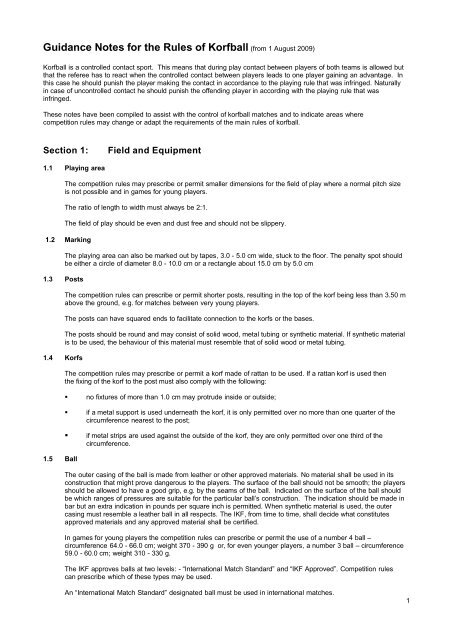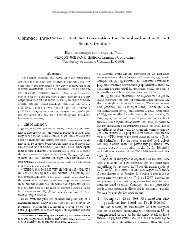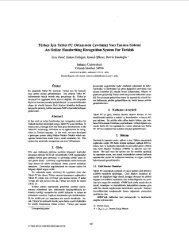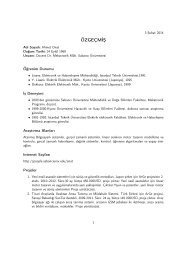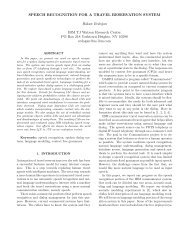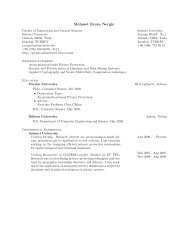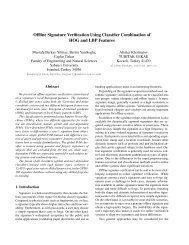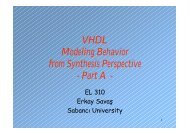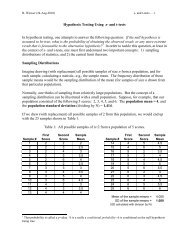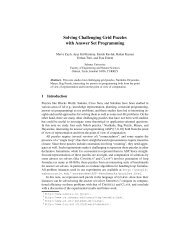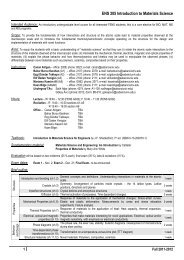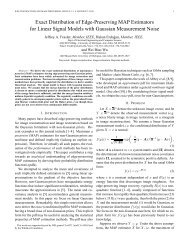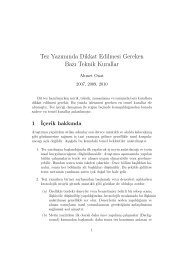Guidance Notes for the Rules of Korfball (from 1 August 2009)
Guidance Notes for the Rules of Korfball (from 1 August 2009)
Guidance Notes for the Rules of Korfball (from 1 August 2009)
Create successful ePaper yourself
Turn your PDF publications into a flip-book with our unique Google optimized e-Paper software.
<strong>Guidance</strong> <strong>Notes</strong> <strong>for</strong> <strong>the</strong> <strong>Rules</strong> <strong>of</strong> <strong>Korfball</strong> (<strong>from</strong> 1 <strong>August</strong> <strong>2009</strong>)<strong>Korfball</strong> is a controlled contact sport. This means that during play contact between players <strong>of</strong> both teams is allowed butthat <strong>the</strong> referee has to react when <strong>the</strong> controlled contact between players leads to one player gaining an advantage. Inthis case he should punish <strong>the</strong> player making <strong>the</strong> contact in accordance to <strong>the</strong> playing rule that was infringed. Naturallyin case <strong>of</strong> uncontrolled contact he should punish <strong>the</strong> <strong>of</strong>fending player in according with <strong>the</strong> playing rule that wasinfringed.These notes have been compiled to assist with <strong>the</strong> control <strong>of</strong> korfball matches and to indicate areas wherecompetition rules may change or adapt <strong>the</strong> requirements <strong>of</strong> <strong>the</strong> main rules <strong>of</strong> korfball.Section 1:Field and Equipment1.1 Playing areaThe competition rules may prescribe or permit smaller dimensions <strong>for</strong> <strong>the</strong> field <strong>of</strong> play where a normal pitch sizeis not possible and in games <strong>for</strong> young players.The ratio <strong>of</strong> length to width must always be 2:1.The field <strong>of</strong> play should be even and dust free and should not be slippery.1.2 MarkingThe playing area can also be marked out by tapes, 3.0 - 5.0 cm wide, stuck to <strong>the</strong> floor. The penalty spot shouldbe ei<strong>the</strong>r a circle <strong>of</strong> diameter 8.0 - 10.0 cm or a rectangle about 15.0 cm by 5.0 cm1.3 Posts1.4 Korfs1.5 BallThe competition rules can prescribe or permit shorter posts, resulting in <strong>the</strong> top <strong>of</strong> <strong>the</strong> korf being less than 3.50 mabove <strong>the</strong> ground, e.g. <strong>for</strong> matches between very young players.The posts can have squared ends to facilitate connection to <strong>the</strong> korfs or <strong>the</strong> bases.The posts should be round and may consist <strong>of</strong> solid wood, metal tubing or syn<strong>the</strong>tic material. If syn<strong>the</strong>tic materialis to be used, <strong>the</strong> behaviour <strong>of</strong> this material must resemble that <strong>of</strong> solid wood or metal tubing.The competition rules may prescribe or permit a korf made <strong>of</strong> rattan to be used. If a rattan korf is used <strong>the</strong>n<strong>the</strong> fixing <strong>of</strong> <strong>the</strong> korf to <strong>the</strong> post must also comply with <strong>the</strong> following:• no fixtures <strong>of</strong> more than 1.0 cm may protrude inside or outside;• if a metal support is used underneath <strong>the</strong> korf, it is only permitted over no more than one quarter <strong>of</strong> <strong>the</strong>circumference nearest to <strong>the</strong> post;• if metal strips are used against <strong>the</strong> outside <strong>of</strong> <strong>the</strong> korf, <strong>the</strong>y are only permitted over one third <strong>of</strong> <strong>the</strong>circumference.The outer casing <strong>of</strong> <strong>the</strong> ball is made <strong>from</strong> lea<strong>the</strong>r or o<strong>the</strong>r approved materials. No material shall be used in itsconstruction that might prove dangerous to <strong>the</strong> players. The surface <strong>of</strong> <strong>the</strong> ball should not be smooth; <strong>the</strong> playersshould be allowed to have a good grip, e.g. by <strong>the</strong> seams <strong>of</strong> <strong>the</strong> ball. Indicated on <strong>the</strong> surface <strong>of</strong> <strong>the</strong> ball shouldbe which ranges <strong>of</strong> pressures are suitable <strong>for</strong> <strong>the</strong> particular ball’s construction. The indication should be made inbar but an extra indication in pounds per square inch is permitted. When syn<strong>the</strong>tic material is used, <strong>the</strong> outercasing must resemble a lea<strong>the</strong>r ball in all respects. The IKF, <strong>from</strong> time to time, shall decide what constitutesapproved materials and any approved material shall be certified.In games <strong>for</strong> young players <strong>the</strong> competition rules can prescribe or permit <strong>the</strong> use <strong>of</strong> a number 4 ball –circumference 64.0 - 66.0 cm; weight 370 - 390 g or, <strong>for</strong> even younger players, a number 3 ball – circumference59.0 - 60.0 cm; weight 310 - 330 g.The IKF approves balls at two levels: - “International Match Standard” and “IKF Approved”. Competition rulescan prescribe which <strong>of</strong> <strong>the</strong>se types may be used.An “International Match Standard” designated ball must be used in international matches.1
1.6 Equipment <strong>of</strong> players and <strong>of</strong>ficialsCompetition rules may require <strong>the</strong> teams to have numbered costumes. The players and <strong>of</strong>ficials must wearshoes.Section 2:Persons2.1 PlayersabNumbers and positionLine up and incomplete teamsThe game cannot continue when, <strong>for</strong> instance, side A has 4 male and 2 female players and side B has 4female and 2 male players.If it is possible to satisfy <strong>the</strong> conditions in this rule in more than one way, <strong>the</strong>n <strong>the</strong> referee decides - aftertaking <strong>the</strong> advice <strong>of</strong> both coaches - which <strong>of</strong> <strong>the</strong> possible changes will be adopted. He will try to avoidunfair advantage to one <strong>of</strong> <strong>the</strong> two sides and will try to keep <strong>the</strong> number <strong>of</strong> changes as few as possible. In<strong>the</strong> absence <strong>of</strong> a coach <strong>the</strong> team captain should be consulted and has <strong>the</strong> right to request a change in <strong>the</strong>initial line up.cSubstitution <strong>of</strong> playersThe competition rules may vary <strong>the</strong> number <strong>of</strong> players <strong>of</strong> a team that can be substituted without <strong>the</strong>approval <strong>of</strong> <strong>the</strong> referee.The coach (see § 2.2 b) must in<strong>for</strong>m <strong>the</strong> referee <strong>of</strong> intended player substitution. Substitution itself isnot a valid reason to interrupt play. Failure to in<strong>for</strong>m <strong>the</strong> referee <strong>of</strong> a substitution shall be deemed tobe misbehaviour.Time required <strong>for</strong> substitution will not be part <strong>of</strong> <strong>the</strong> game’s duration (see § 3.1 c).Substitution must be done quickly. Time wasting during substitution may be punished according to § 3.6 g(delaying <strong>the</strong> game unnecessarily)If substitutes were not immediately available <strong>the</strong>n <strong>the</strong> line up should be changed in accordance with §2.1 b to allow <strong>the</strong> game to be continued. If injured players who are not substituted return, or substitutesbecome available, <strong>the</strong>n <strong>the</strong> original line up is resumed.The competition rules may prescribe that a request by a coach <strong>for</strong> a substitution must be made via<strong>the</strong> scorer (§ 2.4 b).2.2 Captain, Coach, Substitutes and o<strong>the</strong>r persons attached to <strong>the</strong> teamaCaptainMisuse <strong>of</strong> <strong>the</strong> right to draw <strong>the</strong> referee's attention to anything he thinks desirable in <strong>the</strong> interest <strong>of</strong> <strong>the</strong> goodprogress <strong>of</strong> <strong>the</strong> match and/or criticism <strong>of</strong> <strong>the</strong> referee should be considered as misbehaviour and can bepunished by a yellow or red card.bCoachA team may only be accompanied by one coach. He is expected, as such, to make himself known to<strong>the</strong> referee be<strong>for</strong>e <strong>the</strong> start <strong>of</strong> <strong>the</strong> match.If <strong>the</strong> coach takes part in <strong>the</strong> match as a player, he can no longer be considered to be a coach and hisrights as a coach lapse.During a time out <strong>the</strong> coach and his team shall stay on, or in <strong>the</strong> immediate vicinity <strong>of</strong>, <strong>the</strong> bench allocatedto his team.cSubstitutes and o<strong>the</strong>r personsIf a team is accompanied by substitutes and/or o<strong>the</strong>r designated persons attached to <strong>the</strong> team, <strong>the</strong>nduring <strong>the</strong> game those persons must remain seated on <strong>the</strong> bench. No o<strong>the</strong>r person is allowed to sit on<strong>the</strong> bench.2
For how <strong>the</strong> time out is administered by <strong>the</strong> referee see <strong>the</strong> guidance notes <strong>for</strong> § 3.1 b.In <strong>the</strong> case <strong>of</strong> a bleeding player <strong>the</strong> player must leave <strong>the</strong> field <strong>of</strong> play immediately and may not returnuntil <strong>the</strong> bleeding has stopped, <strong>the</strong> wound has been covered and <strong>the</strong> blood has been removed.Where a timekeeper has been appointed in accordance with § 2.4 a and <strong>the</strong> competition rules haveprescribed that in <strong>the</strong> last two minutes <strong>of</strong> each half <strong>the</strong> time clock shall be stopped whenever <strong>the</strong> refereeblows his whistle to stop <strong>the</strong> game (see <strong>the</strong> guidance notes <strong>for</strong> § 3.1), <strong>the</strong> signal <strong>for</strong> ending each half <strong>of</strong> <strong>the</strong>match shall be made by <strong>the</strong> timekeeper.fto take action against misbehaviour by <strong>the</strong> players, coaches, substitute players and o<strong>the</strong>r personsattached to <strong>the</strong> teamMisbehaviour includes: -• striking, punching, kicking or intentionally running down an opponent• repeated infringement <strong>of</strong> <strong>the</strong> rules, especially after a warning• <strong>the</strong> deliberate moving <strong>of</strong> <strong>the</strong> post during a shot• <strong>the</strong> utterance <strong>of</strong> insults, no matter to whom addressed• making remarks against <strong>the</strong> referee about his knowledge <strong>of</strong> <strong>the</strong> rules• leaving <strong>the</strong> field without in<strong>for</strong>ming <strong>the</strong> referee• delaying <strong>the</strong> retaking <strong>of</strong> positions after a time out and failing to in<strong>for</strong>m <strong>the</strong> referee <strong>of</strong> a substitutionBoth teams intentionally delaying <strong>the</strong> game in turns can also be regarded as misbehaviour (see <strong>the</strong>guidance note <strong>for</strong> § 3.6 g). As soon as <strong>the</strong> referee notices this type <strong>of</strong> play, he issues a warning toboth captains toge<strong>the</strong>r. If, after <strong>the</strong> referee's warning, both teams continue to play in <strong>the</strong> samemanner, <strong>the</strong> referee is empowered to stop <strong>the</strong> match.The referee can consider any unsporting action as misbehaviour, e.g. inadmissible <strong>for</strong>ms <strong>of</strong> appealor demonstrative gestures against <strong>the</strong> referee.During <strong>the</strong> match <strong>the</strong> referee shall indicate a <strong>for</strong>mal warning by showing a yellow card to <strong>the</strong> player,coach, substitute player or any o<strong>the</strong>r person concerned attached to a team.The referee sends someone <strong>of</strong>f by showing him a red card. A person is sent straight <strong>of</strong>f if he commits acase <strong>of</strong> serious misbehaviour (examples <strong>of</strong> which may be found in <strong>the</strong> referees guidance notes <strong>for</strong> <strong>the</strong>coding <strong>of</strong> <strong>of</strong>fences). In all cases <strong>of</strong> serious misbehaviour an immediate red card is shown whe<strong>the</strong>r or not<strong>the</strong> person had previously had a yellow card shown <strong>for</strong> misbehaviour.A person shown a red card must leave <strong>the</strong> playing area (as defined in § 1.1 <strong>of</strong> <strong>the</strong> <strong>Rules</strong> <strong>of</strong> <strong>Korfball</strong>).The person concerned must sit in <strong>the</strong> area reserved <strong>for</strong> spectators or leave <strong>the</strong> hall altoge<strong>the</strong>r,whatever he chooses.Should any person who has received a yellow card misbehave <strong>for</strong> a second time, <strong>the</strong>n he must be sent <strong>of</strong>f.In this case <strong>the</strong> referee shall first show a yellow card and <strong>the</strong>n immediately follow this by showing a redcard.Competition rules should prescribe when <strong>the</strong> jurisdiction <strong>of</strong> <strong>the</strong> referee starts and ends with respect tooccurrences <strong>of</strong> misconduct <strong>for</strong> which a card can be shown. For IKF matches this will be <strong>from</strong> <strong>the</strong> time<strong>the</strong> team sheet is handed in (declaring which players will start and which players will be substitutes)until <strong>the</strong> match <strong>for</strong>m is signed by <strong>the</strong> captain and referee.Misconduct outside this period may still be reported to <strong>the</strong> appropriate authority in accordance with<strong>the</strong> competition rules or <strong>the</strong> regulations <strong>of</strong> <strong>the</strong> national organization.If misconduct takes place be<strong>for</strong>e <strong>the</strong> match, or during <strong>the</strong> half time period, <strong>the</strong>n <strong>the</strong> yellow or red cardshall be shown to <strong>the</strong> player, coach, substitute player or any o<strong>the</strong>r person attached to <strong>the</strong> teamconcerned at that time and <strong>the</strong> captain and coach <strong>of</strong> both teams shall be in<strong>for</strong>med be<strong>for</strong>e <strong>the</strong> next halfbegins.If <strong>the</strong> competition regulations allow it, a yellow or red card may be shown <strong>for</strong> any misconduct thattakes place immediately after <strong>the</strong> match.Unless stated o<strong>the</strong>rwise in <strong>the</strong> competition regulations, this will be at any time up to when <strong>the</strong> match <strong>for</strong>m(which shall list any cards shown be<strong>for</strong>e, during, or immediately after <strong>the</strong> match) is signed by <strong>the</strong> captainand referee. Since <strong>the</strong> match <strong>for</strong>m is signed by a representative <strong>of</strong> <strong>the</strong> team concerned (i.e. <strong>the</strong> captain), itshall be sufficient <strong>for</strong> <strong>the</strong> card to be shown to <strong>the</strong> person concerned and <strong>the</strong> fact recorded on <strong>the</strong> match<strong>for</strong>m.A coach or substitute player who has been given a red card may not subsequently take part in <strong>the</strong> matchas a player or sit on <strong>the</strong> team bench. He must leave <strong>the</strong> playing area completely.4
The competition rules can prescribe or permit that yellow and red cards are not used when a <strong>for</strong>malwarning is given to a player, or when a player is sent <strong>of</strong>f, if <strong>the</strong> players taking part in <strong>the</strong> game are undera certain age limit.gto take action against interference by <strong>the</strong> publicIn <strong>the</strong> case <strong>of</strong> interference by <strong>the</strong> spectators, <strong>the</strong> referee will ask <strong>the</strong> captain to have this stopped. In <strong>the</strong>case <strong>of</strong> repetition <strong>the</strong> referee may adjourn, or terminate <strong>the</strong> match, as circumstances require.2.4 Timekeeper and scoreraWhere possible, a timekeeper shall be appointed.Unless <strong>the</strong> competition rules prescribe that <strong>the</strong> timing <strong>of</strong> <strong>the</strong> match shall be <strong>the</strong> responsibility <strong>of</strong> <strong>the</strong>timekeeper (see <strong>the</strong> guidance note <strong>for</strong> § 3.1) <strong>the</strong>n <strong>the</strong> duty <strong>of</strong> <strong>the</strong> timekeeper shall be to warn <strong>the</strong> refereejust be<strong>for</strong>e <strong>the</strong> end <strong>of</strong> each half <strong>of</strong> <strong>the</strong> game.The referee has <strong>the</strong> responsibility to check that <strong>the</strong> clock is being stopped and started correctlyin accordance with <strong>the</strong> rules.The assistant referee can act as timekeeper.bWhere possible, a scorer shall be appointed.The duty <strong>of</strong> <strong>the</strong> scorer shall be to keep <strong>the</strong> record <strong>of</strong> <strong>the</strong> match.The competition rules may prescribe that requests <strong>for</strong> time-outs and substitutions shall be made via<strong>the</strong> scorer and not direct to <strong>the</strong> referee.cWhen play has stopped, <strong>the</strong> timekeeper may also make an audible signal to <strong>the</strong> referee to advisehim that one <strong>of</strong> <strong>the</strong> teams has requested a time-out or substitution.2.5 Assistant refereeWhere an audible signal is used by <strong>the</strong> timekeeper to indicate a request <strong>for</strong> a time-out or substitutionthis shall be a buzzer, bell or hooter.When such a signal is used <strong>the</strong>n <strong>the</strong> scorer shall use a sign to indicate whe<strong>the</strong>r a time-out orsubstitution has been requested and by which team.The competition rules may prescribe <strong>the</strong> use <strong>of</strong> no assistant referee.The assistant referee shall preferably be dressed in a similar costume to <strong>the</strong> referee (see § 1.6).The competition rules may prescribe that additional means <strong>of</strong> communication, o<strong>the</strong>r than just <strong>the</strong> flag, may beused between <strong>the</strong> referee and <strong>the</strong> assistant referee (e.g. microphone and earpiece; buzzer system incorporatedinto <strong>the</strong> flag etc.).In cases <strong>of</strong> doubt <strong>the</strong> referee asks <strong>the</strong> opinion <strong>of</strong> <strong>the</strong> assistant referee regarding decisions to be taken on <strong>the</strong>field. On <strong>the</strong> advice <strong>of</strong> <strong>the</strong> assistant referee he may change his previous decision provided he has not re-startedplay.O<strong>the</strong>r tasks that may be done by <strong>the</strong> assistant referee are:• to act as timekeeper (see <strong>the</strong> guidance note <strong>for</strong> § 2.4)• to bring to <strong>the</strong> referee’s attention misconduct <strong>of</strong> players, coaches, substitute players and any o<strong>the</strong>rpersons attached to <strong>the</strong> team• to bring to <strong>the</strong> referee’s attention any foul taking place outside <strong>the</strong> view <strong>of</strong> <strong>the</strong> referee• to bring to <strong>the</strong> referee’s attention a request <strong>of</strong> a coach concerning tasks listed in § 2.2 b.Section 3: The game3.1 Duration and time-outaThe length <strong>of</strong> a matchThe competition rules may prescribe a different length <strong>of</strong> match and half time break. A shorter durationis desirable in matches with younger players.If deemed sufficiently important by <strong>the</strong> referee, any delays in <strong>the</strong> first half or second half caused by aninfringement <strong>of</strong> § 3.6 g (<strong>for</strong> instance explanations 2 and 4 in <strong>the</strong> guidance notes), or any outside5
influence (including <strong>the</strong> treatment <strong>of</strong> injuries), may be deemed to be delays outside <strong>the</strong> course <strong>of</strong> <strong>the</strong>game and <strong>the</strong> referee must leng<strong>the</strong>n <strong>the</strong> duration <strong>of</strong> that half accordingly.Whenever a timekeeper is appointed in accordance with § 2.4 <strong>the</strong>n <strong>the</strong> competition rules may prescribe that<strong>the</strong> end <strong>of</strong> each half shall be on <strong>the</strong> sounding <strong>of</strong> <strong>the</strong> timekeeper’s signal and not on <strong>the</strong> referee’s whistle.Fur<strong>the</strong>rmore, <strong>the</strong> competition rules may prescribe a period at <strong>the</strong> end <strong>of</strong> each half where <strong>the</strong> time clockshall be stopped whenever <strong>the</strong> referee blows his whistle to stop <strong>the</strong> game. This period shall be a maximumperiod <strong>of</strong> 5 minutes. The timing shall be re-started when <strong>the</strong> referee blows his whistle <strong>for</strong> <strong>the</strong> game to restart(except at <strong>the</strong> taking <strong>of</strong> a penalty).In <strong>the</strong> case <strong>of</strong> a penalty <strong>the</strong> clock shall be re-startedi. after a score – with <strong>the</strong> throw <strong>of</strong>fii. after a missed penalty – with <strong>the</strong> first touch <strong>of</strong> <strong>the</strong> ball by any player.bTime-outCompetition rules may vary <strong>the</strong> number <strong>of</strong> time-outs allowed per team.Fur<strong>the</strong>r stipulations may be inserted in <strong>the</strong> competition rules concerning <strong>the</strong> levels <strong>of</strong> play and <strong>the</strong>age groups within which <strong>the</strong> right to make a request <strong>for</strong> a time-out may be used.The referee may only be asked <strong>for</strong> a time-out by <strong>the</strong> coach when <strong>the</strong> play is stopped. Unlesso<strong>the</strong>rwise specified in <strong>the</strong> competition rules which may prescribe that a request by a coach <strong>for</strong> atime-out must bemade via <strong>the</strong> scorer (§ 2.4 b), <strong>the</strong> coach makes a request to <strong>the</strong> referee <strong>for</strong> a time-out and he confirms to<strong>the</strong>referee that his request concerns a time-out by making a T-signal with both hands.The referee indicates <strong>the</strong> start <strong>of</strong> <strong>the</strong> time-out by giving a T-signal and by whistling at <strong>the</strong> same time. After45 seconds <strong>the</strong> referee blows his whistle to indicate that both teams have to retake <strong>the</strong>ir positions. Thegame has to be restarted within 60 seconds <strong>of</strong> <strong>the</strong> start <strong>of</strong> <strong>the</strong> time-out.A time-out must be completed by <strong>the</strong> game restarting be<strong>for</strong>e any new time-out can be given.cSubstitutionAs substitutions are not part <strong>of</strong> <strong>the</strong> playing time, <strong>the</strong> timing <strong>of</strong> <strong>the</strong> game shall stop at <strong>the</strong> moment a coachhas his request <strong>for</strong> a substitution acknowledged by <strong>the</strong> referee. The timing shall re-start at <strong>the</strong> moment <strong>the</strong>whistle is blown <strong>for</strong> <strong>the</strong> re-start <strong>of</strong> <strong>the</strong> match. In <strong>the</strong> case <strong>of</strong> a red card being shown to a player <strong>the</strong> timingshall only stop if <strong>the</strong> coach requests a substitution.3.2 GoalsabcHow to scorePrevious infringementGoal not allowedIf <strong>the</strong> referee has observed an infringement committed by <strong>the</strong> attacking side but has not blown <strong>for</strong> <strong>the</strong>infringement until after <strong>the</strong> ball has gone through <strong>the</strong> korf he is still allowed to disallow <strong>the</strong> goal and punish<strong>the</strong> infringement.dThe team scoring <strong>the</strong> most goals wins <strong>the</strong> match3.3 Line upaChoice <strong>of</strong> line upIn IKF tournaments <strong>the</strong> teams shall toss to decide which team will attack which korf in <strong>the</strong> first half. In IKFfriendly matches, <strong>the</strong> home team shall choose.In IKF tournaments each team shall declare in advance to <strong>the</strong> referee or jury which <strong>of</strong> its players shall be• in its first attack zone• in its first defence zone• its substitutes.Unless mutually agreed o<strong>the</strong>rwise, <strong>the</strong> same principle shall apply to friendly international matches.When both sides are incomplete <strong>the</strong>n <strong>the</strong> captain <strong>of</strong> <strong>the</strong> team that is not starting <strong>the</strong> first half must place6
his players in such a way that <strong>the</strong> number <strong>of</strong> players without a direct opponent is a minimum.bChange in line upSee § 2.1 b.3.4 Zone changes and changes <strong>of</strong> endsThe competition rules can stipulate o<strong>the</strong>r arrangements, e.g. in matches <strong>for</strong> young players or in tournamentswhere <strong>the</strong> length <strong>of</strong> <strong>the</strong> match is much shorter.3.5 Throw <strong>of</strong>fIn IKF tournaments <strong>the</strong> team winning <strong>the</strong> toss used in § 3.3a shall also take <strong>the</strong> throw <strong>of</strong>f at <strong>the</strong> start <strong>of</strong> <strong>the</strong> match.In IKF friendly matches, <strong>the</strong> home team shall take <strong>the</strong> throw <strong>of</strong>f at <strong>the</strong> start <strong>of</strong> <strong>the</strong> match.3.6 Infringements <strong>of</strong> <strong>the</strong> rulesDuring <strong>the</strong> game it is prohibited:abto touch <strong>the</strong> ball with leg or footto hit <strong>the</strong> ball with <strong>the</strong> fistAll hitting with a clenched fist is punishable, even when <strong>the</strong> ball is actually touched by <strong>the</strong> wrist or <strong>the</strong> back<strong>of</strong> <strong>the</strong> hand.cto take hold <strong>of</strong>, catch or tap <strong>the</strong> ball when any part <strong>of</strong> <strong>the</strong> body o<strong>the</strong>r than <strong>the</strong> feet is touching <strong>the</strong>groundWhen a player who is already in possession <strong>of</strong> <strong>the</strong> ball falls, <strong>the</strong>n he is allowed stand up after having fallenwith <strong>the</strong> ball or to play <strong>the</strong> ball <strong>from</strong> his fallen position.dto run with <strong>the</strong> ballA player taking a long throw <strong>from</strong> a stationary position is allowed to place one foot <strong>for</strong>ward and lift hiso<strong>the</strong>r foot at <strong>the</strong> end <strong>of</strong> <strong>the</strong> throwing motion be<strong>for</strong>e <strong>the</strong> ball has left his hands.A player should not be penalised <strong>for</strong> moving a little over <strong>the</strong> field during a throw that is discontinuedbe<strong>for</strong>e completion.In deciding on <strong>the</strong> question whe<strong>the</strong>r a player has done everything to stop etc., <strong>the</strong> referee must consider<strong>the</strong> condition <strong>of</strong> <strong>the</strong> field, as well as <strong>the</strong> speed and <strong>the</strong> technical capacity <strong>of</strong> <strong>the</strong> player.When <strong>the</strong> player seizes <strong>the</strong> ball while he is obviously in contact with <strong>the</strong> ground, <strong>the</strong>n this contact has tobe considered as <strong>the</strong> first time that <strong>the</strong> player has placed a foot on <strong>the</strong> ground after receiving <strong>the</strong> ball.esolo-playExamples <strong>of</strong> solo play are:• <strong>the</strong> player throws <strong>the</strong> ball away with <strong>the</strong> intention <strong>of</strong> collecting it elsewhere. This is notallowed even if he throws <strong>the</strong> ball against ano<strong>the</strong>r player or against <strong>the</strong> post. On <strong>the</strong> o<strong>the</strong>rhand, when a player tries to pass <strong>the</strong> ball to ano<strong>the</strong>r player but <strong>the</strong> latter fails to catch <strong>the</strong>ball, <strong>the</strong>n <strong>the</strong> first player is allowed to recover <strong>the</strong> ball.• The player taps <strong>the</strong> ball along while running beside it.Examples where solo play should not be punished:• Solo-play is never punishable when <strong>the</strong> player in question is not changing his position; e.g.a player, while standing still, throws <strong>the</strong> ball <strong>from</strong> one hand to <strong>the</strong> o<strong>the</strong>r, or bounces <strong>the</strong> ballto <strong>the</strong> ground first and seizes it afterwards.• When he does move. The criterion is whe<strong>the</strong>r he intentionally avoided cooperation.• Tapping <strong>the</strong> ball along will not be punished when <strong>the</strong> ball cannot be seized directly. On <strong>the</strong>o<strong>the</strong>r hand when <strong>the</strong> ball could have been taken earlier, <strong>the</strong>n tapping along and seizing itafterwards is <strong>for</strong>bidden. Tapping along must also be punished when it is done because itmakes <strong>the</strong> later seizing <strong>of</strong> <strong>the</strong> ball easier.• It <strong>of</strong>ten occurs that two opponents contest <strong>the</strong> ball ei<strong>the</strong>r by jumping <strong>for</strong> it or by bothreaching <strong>for</strong> it whilst running next to each o<strong>the</strong>r in a stooping position. If one <strong>of</strong> <strong>the</strong> players7
A player is allowed to position himself in <strong>the</strong> path <strong>of</strong> <strong>the</strong> approaching opponent provided:• that by extending his arms or legs he does not <strong>for</strong>ce <strong>the</strong> opponent to take a longer wayround than necessary to avoid personal contact• he does not jump so suddenly in <strong>the</strong> path <strong>of</strong> <strong>the</strong> opponent that <strong>the</strong> opponent is unableto avoid a collision.Repeated violations <strong>of</strong> <strong>the</strong> above conditions can lead to a penalty according to § 3.11 a, explanation B.On <strong>the</strong> o<strong>the</strong>r hand, <strong>the</strong> attacker must try to avoid a collision with <strong>the</strong> defender. When <strong>the</strong> attacker runsagainst a defender to put him <strong>of</strong>f balance or when he pushes him out <strong>of</strong> his defending position with hisarm or shoulder, <strong>the</strong>n <strong>the</strong> attacker infringes § 3.6 i.When a player cannot follow an opponent because ano<strong>the</strong>r opponent positions himself in <strong>the</strong> path <strong>of</strong><strong>the</strong> player, <strong>the</strong>n <strong>the</strong> latter opponent violates § 3.6 i (holding-<strong>of</strong>f).It <strong>of</strong>ten occurs that two players touch each o<strong>the</strong>r in an ef<strong>for</strong>t to seize <strong>the</strong> ball. Such contact will only bepunished if it is <strong>the</strong> result <strong>of</strong> recklessness or holding-<strong>of</strong>f. In <strong>the</strong>se cases <strong>the</strong> referee has to decide who is tobe blamed. This may be ei<strong>the</strong>r <strong>the</strong> player to whom <strong>the</strong> ball is passed, or his opponent who tried tointercept. The so-called "jumping at <strong>the</strong> line" should only be punished if <strong>the</strong> opponent has been hamperedin freely using his body. No <strong>of</strong>fence is committed when <strong>the</strong> defender taps <strong>the</strong> ball be<strong>for</strong>e it has comewithin <strong>the</strong> reach <strong>of</strong> <strong>the</strong> attacker. On <strong>the</strong> o<strong>the</strong>r hand, an <strong>of</strong>fence is committed if <strong>the</strong> defender, standing nextto or behind <strong>the</strong> attacker, hangs over him, hampers him in catching and <strong>the</strong>n taps <strong>the</strong> ball.The tapping <strong>of</strong> <strong>the</strong> ball while jumping can only be punished if it leads to physical contact degeneratinginto running down or jumping-down.jto hinder an opponent excessivelyUnexpected movements by an opponent will <strong>of</strong>ten cause a restriction in a player's freedom <strong>of</strong> movement.Such cases will not be punished, provided immediate action is taken by <strong>the</strong> opponent to restore <strong>the</strong>player's freedom <strong>of</strong> movement.When <strong>the</strong> hindering arm and hand are brought in <strong>the</strong> path <strong>of</strong> <strong>the</strong> throwing arm in trying to counter <strong>the</strong> ball,no infringement is possible when <strong>the</strong> hindering player touches <strong>the</strong> ball after it has already left <strong>the</strong> hand <strong>of</strong><strong>the</strong> thrower.If contact is made when <strong>the</strong> ball is still on <strong>the</strong> hand <strong>of</strong> <strong>the</strong> thrower <strong>the</strong>n no foul is committed when<strong>the</strong> hindering arm or hand is at rest. On <strong>the</strong> o<strong>the</strong>r hand an infringement is committed when <strong>the</strong> armmoves towards <strong>the</strong> ball at <strong>the</strong> moment <strong>the</strong> ball is thrown. If contact is only slight and <strong>the</strong> pass is notaffected unfavourably, <strong>the</strong>n <strong>the</strong> referee can apply <strong>the</strong> advantage rule and allow play to continue.Strong action must be taken when <strong>the</strong> hindering degenerates into "hitting" even when <strong>the</strong> throw does notfail (except when a scoring chance results <strong>from</strong> <strong>the</strong> throw: <strong>the</strong> referee will <strong>the</strong>n await <strong>the</strong> result and warn<strong>the</strong> <strong>of</strong>fending player later).kto hinder an opponent <strong>of</strong> <strong>the</strong> opposite sex in throwing <strong>the</strong> ballThe rule can only be broken when <strong>the</strong> player who is in possession <strong>of</strong> <strong>the</strong> ball is actually trying to throw it.Any action that impedes throwing must be considered as hindering.Any distance greater than <strong>the</strong> combined arms’ lengths <strong>of</strong> <strong>the</strong> two players concerned will mean thathindering is not taking place and <strong>the</strong>re<strong>for</strong>e no <strong>of</strong>fence is being committed.lto hinder an opponent who is already being hindered by ano<strong>the</strong>r playerJust like in § 3.6 k <strong>the</strong> rule can only be broken when <strong>the</strong> player who is in possession <strong>of</strong> <strong>the</strong> ball isactually trying to throw it.Any action that impedes throwing must be considered as hindering. When two defenders hinder anattacker who is in possession <strong>of</strong> <strong>the</strong> ball, <strong>the</strong> referee should observe carefully to see if <strong>the</strong> defender whowas <strong>the</strong> first to hinder has satisfied <strong>the</strong> conditions <strong>of</strong> § 3.6 n. If he does and <strong>the</strong> attacker shoots, <strong>the</strong>re isno question <strong>of</strong> breaking § 3.6 l (see <strong>the</strong> guidance note <strong>for</strong> § 3.6 n). However, if <strong>the</strong> defender who was <strong>the</strong>first to hinder did not satisfy <strong>the</strong> conditions <strong>of</strong> § 3.6 n and <strong>the</strong> shot, or <strong>the</strong> pass to ano<strong>the</strong>r attacker in ascoring position, fails because <strong>of</strong> <strong>the</strong> hindering by more than one defender, <strong>the</strong>n a penalty will beawarded .9
mto play outside one’s zoneWhen a player, playing outside his zone, touches <strong>the</strong> ball, <strong>the</strong>n <strong>the</strong> point where <strong>the</strong> ball was touched is<strong>the</strong> point where <strong>the</strong> infringement occurred. The rule regarding <strong>the</strong> touching <strong>of</strong> <strong>the</strong> ball by a player incontact with <strong>the</strong> line applies both to <strong>the</strong> line dividing <strong>the</strong> zones and <strong>the</strong> boundary lines <strong>of</strong> <strong>the</strong> field.For touching <strong>the</strong> ball outside <strong>the</strong> field <strong>of</strong> play see § 3.7.In a case <strong>of</strong> unlawful hindering, <strong>the</strong> re-start must be taken according to § 3.9 b <strong>from</strong> <strong>the</strong> point where<strong>the</strong> hindering occurred.nto shoot <strong>from</strong> a defended positionThe rule against defended shooting is based on <strong>the</strong> desire to prevent slick hand and arm movementsbeing rewarded by a goal, and to encourage players to cooperate toge<strong>the</strong>r to attain free positions <strong>from</strong>which shots may be taken.The rule makes it clear that a shot cannot be considered defended if:1 The defender doesn’t actually try to block <strong>the</strong> shot (<strong>the</strong> simple raising <strong>of</strong> <strong>the</strong> arms is insufficient)2 The body <strong>of</strong> <strong>the</strong> defender is fur<strong>the</strong>r <strong>from</strong> <strong>the</strong> post than that <strong>of</strong> <strong>the</strong> attacker. It is not sufficient when<strong>the</strong> defender's hand or arm is nearer <strong>the</strong> post3 The defender is at a greater distance than arm’s length4 The defender has his back to <strong>the</strong> attacker and is not facing him5 The defender is unaware that <strong>the</strong> attacker has <strong>the</strong> ball in possession (very fast shot, tapping)The rule does not state that <strong>the</strong> defender must actually be able to hinder <strong>the</strong> shot. For instance, when<strong>the</strong> attacker is much taller than <strong>the</strong> defender, <strong>the</strong> attacker will probably always be able to shoot in such away that <strong>the</strong> defender cannot block <strong>the</strong> ball. The shot must be considered defended if <strong>the</strong> defendersatisfies all <strong>of</strong> <strong>the</strong> conditions laid down in § 3.6 n. The same applies when <strong>the</strong> attacker, having jumpedup, shoots or taps <strong>the</strong> ball over <strong>the</strong> hindering arms <strong>of</strong> <strong>the</strong> defender towards <strong>the</strong> korf.If an attacker, hindered by a defender satisfying all <strong>of</strong> <strong>the</strong> conditions mentioned in § 3.6 n, still shoots aftera second defender has started hindering, <strong>the</strong>re is no question <strong>of</strong> an infringement <strong>of</strong> § 3.6 1. Instead <strong>the</strong>attacker is penalised because <strong>of</strong> shooting <strong>from</strong> a defended position.The following cases require special attention:• An attacker receives <strong>the</strong> ball while he has his back to <strong>the</strong> korf and <strong>the</strong> defender is behind himand <strong>the</strong>re<strong>for</strong>e nearer <strong>the</strong> post. If <strong>the</strong> attacker shoots <strong>from</strong> this position, i.e. backwards, <strong>the</strong>nprovided <strong>the</strong> defender satisfies all <strong>of</strong> <strong>the</strong> conditions <strong>of</strong> § 3.6 n <strong>the</strong> shot must be considereddefended.• During an underhand shot against a tall defender, <strong>the</strong>re is <strong>the</strong> possibility that <strong>the</strong> defendertouches <strong>the</strong> ball. This touching can also occur when <strong>the</strong> defender jumps up very high. Touching<strong>of</strong> <strong>the</strong> ball by <strong>the</strong> defender is, in itself, not a reason to consider <strong>the</strong> shot defended. The criterion isthat <strong>the</strong> defender must be within arm's length at <strong>the</strong> instant <strong>the</strong> shot is taken as well as fulfilling<strong>the</strong> o<strong>the</strong>r conditions.• An attacker shoots while running towards <strong>the</strong> post, while <strong>the</strong> defender is behind him. Defendedshooting is <strong>the</strong>n not possible. The defender is allowed to try to block <strong>the</strong> shot by hindering <strong>from</strong>behind, but <strong>of</strong>ten he will <strong>the</strong>n violate § 3.6 j (hinder an opponent excessively). A penalty should<strong>the</strong>n be given if <strong>the</strong> violation causes <strong>the</strong> shot to fail.• An attacker stands in a defended position. If <strong>the</strong> attacker steps, or jumps backwards, (withoutinfringing <strong>the</strong> running rule - § 3.6 d) and shoots, and <strong>the</strong> defender tries to follow <strong>the</strong> movement <strong>of</strong><strong>the</strong> attacker and actually tries to block <strong>the</strong> shot, <strong>the</strong>n <strong>the</strong> shot must be considered defended,even if <strong>the</strong> attacker is <strong>for</strong> a short period out <strong>of</strong> arm’s length.oto shoot after cutting past ano<strong>the</strong>r attackerIf <strong>the</strong> defender is not at arm’s length <strong>from</strong> <strong>the</strong> attacker when <strong>the</strong> attacker runs close by a team mate,<strong>the</strong>n <strong>the</strong>re can be no question <strong>of</strong> 'cutting' and <strong>the</strong> shot must be allowed.When a defender cannot follow an attacker because ano<strong>the</strong>r attacker deliberately moves into <strong>the</strong> path <strong>of</strong><strong>the</strong> defender <strong>the</strong>n <strong>the</strong> 'cutting' is a <strong>for</strong>m <strong>of</strong> holding-<strong>of</strong>f (§ 3.6 i) and a re-start is awarded against <strong>the</strong> o<strong>the</strong>rattacker, whe<strong>the</strong>r or not <strong>the</strong> first attacker shoots after <strong>the</strong> 'cutting'.pto score <strong>from</strong> <strong>the</strong> defence zone <strong>of</strong> <strong>the</strong> attacking team or directly <strong>from</strong> a free pass or a re-start10
qto shoot when one plays without a personal opponentIf <strong>the</strong> coach <strong>of</strong> <strong>the</strong> attacking side fails to in<strong>for</strong>m <strong>the</strong> referee, <strong>the</strong>n <strong>the</strong> referee must see to it that he does soat once.rto influence a shot by moving <strong>the</strong> postThe goal counts if <strong>the</strong> ball goes through <strong>the</strong> korf after a defender has moved <strong>the</strong> post. The goal countseven if <strong>the</strong> referee has already blown <strong>for</strong> this <strong>of</strong>fence by <strong>the</strong> defender (see § 3.2).A penalty will be awarded if <strong>the</strong> movement <strong>of</strong> <strong>the</strong> post by a defender might have prevented a goal.The penalty is awarded because a scoring chance was lost.If an attacker moves <strong>the</strong> post and <strong>the</strong> ball goes through <strong>the</strong> korf <strong>the</strong>n a re-start will be awarded to<strong>the</strong> defence.If an attacker moves <strong>the</strong> post and <strong>the</strong> ball does not go through <strong>the</strong> korf <strong>the</strong>n <strong>the</strong> referee will not blow hiswhistle unless <strong>the</strong> ball bounces back in a direction favourable to <strong>the</strong> attack. In this case he will award are- start to <strong>the</strong> defence.The referee will not blow his whistle when <strong>the</strong> post is moved by a defender and <strong>the</strong> ball misses <strong>the</strong> korfby such a margin that moving <strong>the</strong> post could not have influenced <strong>the</strong> result <strong>of</strong> <strong>the</strong> shot.sto take hold <strong>of</strong> <strong>the</strong> post when jumping, running or in order to move away quicklyExamples <strong>of</strong> a player doing this are:• to reach higher during a jump• in order to change direction quickly with <strong>the</strong> aid <strong>of</strong> <strong>the</strong> post• pushing against <strong>the</strong> post to move away quickly.tto violate <strong>the</strong> conditions laid down <strong>for</strong> a free pass or a penaltyThe <strong>of</strong>fence can be committed by• <strong>the</strong> player taking <strong>the</strong> throw (e.g. waiting too long be<strong>for</strong>e taking <strong>the</strong> throw; touching<strong>the</strong> ground between <strong>the</strong> post and penalty spot when taking a penalty)• by one <strong>of</strong> his team mates (e.g. coming within <strong>the</strong> prescribed distance).• by an opponent (e.g. coming within <strong>the</strong> prescribed distance; influencing <strong>the</strong> result <strong>of</strong> apenalty).uto play in a dangerous mannerAn example <strong>of</strong> this is <strong>for</strong> an attacker to <strong>for</strong>ce his defender, who is within arm’s distance <strong>of</strong> <strong>the</strong> attacker, tocollide at speed with ano<strong>the</strong>r attacker. This situation occurs when an attacker takes his path in a way tha<strong>the</strong> subsequently <strong>for</strong>ces his defender, who is within arm’s distance, to collide at speed with ano<strong>the</strong>rattacker.The defender necessarily must not be aware, or be aware too late, that an attacker is standing in his path.In <strong>the</strong> above-mentioned situation it might also be <strong>the</strong> case that a defender causes <strong>the</strong> collision with <strong>the</strong>o<strong>the</strong>r attacker on purpose, despite <strong>the</strong> fact that he is definitely aware <strong>of</strong> <strong>the</strong> attacker in his path, orbecomesaware <strong>of</strong> this situation at such a time that he could avoid a collision. In <strong>the</strong>se situations <strong>the</strong> referee hasto punish <strong>the</strong> defender by awarding a free pass to <strong>the</strong> attacking team.While judging which situation is <strong>the</strong> case, <strong>the</strong> referee must take into account <strong>the</strong> technical and tacticallevel <strong>of</strong> <strong>the</strong> players and <strong>the</strong> speed with which <strong>the</strong> attacker moves towards or past <strong>the</strong> o<strong>the</strong>r attacker.When a light collision takes place, which does not influence <strong>the</strong> continuation <strong>of</strong> <strong>the</strong> game and <strong>for</strong> which<strong>the</strong> defender should be punished, <strong>the</strong> referee may decide to let <strong>the</strong> game go on (“advantage rule”).vto violate <strong>the</strong> conditions laid down <strong>for</strong> a re-startSince it is not permitted to hinder <strong>the</strong> player taking a re-start and <strong>the</strong> ball must travel at least 2.50 m (§3.9), referees should ensure that hindering does not take place. Hindering shall not only include activehindering but also passive hindering where <strong>the</strong> opponent places himself so close to <strong>the</strong> taker <strong>of</strong> <strong>the</strong> re-startthat he prevents <strong>the</strong> ball <strong>from</strong> being brought quickly into play.11
all has left his hands, <strong>the</strong>n <strong>the</strong> referee awards an out-ball to <strong>the</strong> opposing side .3.8 Referee throw-upThe administration <strong>of</strong> a referee throw is undertaken as follows:The referee chooses two players <strong>from</strong> <strong>the</strong> zone concerned, who must be <strong>of</strong> <strong>the</strong> same sex and if possible <strong>of</strong>about <strong>the</strong> same height. The two players take up a position on ei<strong>the</strong>r side <strong>of</strong> <strong>the</strong> referee with <strong>the</strong> defender takingup his position first. The referee throws <strong>the</strong> ball up between <strong>the</strong>m so that its highest point is out <strong>of</strong> <strong>the</strong> reach <strong>of</strong>ei<strong>the</strong>r player and at that moment blows his whistle to indicate <strong>the</strong> re-start <strong>of</strong> <strong>the</strong> match. These two players maytouch <strong>the</strong> ball after <strong>the</strong> ball has reached its highest point during <strong>the</strong> throw-up. The o<strong>the</strong>r players must observe adistance <strong>of</strong>2.50 m <strong>from</strong> <strong>the</strong> place <strong>of</strong> <strong>the</strong> throw-up and may only touch <strong>the</strong> ball after one <strong>of</strong> <strong>the</strong> two selected playershas touched <strong>the</strong> ball or after <strong>the</strong> ball has been in contact with <strong>the</strong> ground.Apart <strong>from</strong> <strong>the</strong> case when two opponents catch <strong>the</strong> ball simultaneously, <strong>the</strong> ball is also thrown-up if:3.9 Re-start• <strong>the</strong> ball touches a spectator or an object inside <strong>the</strong> field <strong>of</strong> play (unless it is clear that one sidewould o<strong>the</strong>rwise have caught <strong>the</strong> ball - see guidance note <strong>of</strong> § 2.3 b - or <strong>the</strong> ball would have goneout – see <strong>the</strong> guidance note <strong>of</strong> § 3.7)• nei<strong>the</strong>r side had a right to <strong>the</strong> ball after <strong>the</strong> game has been interruptedawhen to award a re-startAfter a goal has been awarded, <strong>the</strong> game is always resumed with a throw <strong>of</strong>f in accordance with § 3.5. Anyinfringement <strong>of</strong> § 3.6 g, explanations 2 and 4 in <strong>the</strong> guidance notes, shall not be penalised by a free passor re-start to <strong>the</strong> opponents.bcplace <strong>of</strong> <strong>the</strong> re-startIf <strong>the</strong> player touches <strong>the</strong> ball while he himself touches <strong>the</strong> inner dividing line, <strong>the</strong>n <strong>the</strong> re-start is taken in<strong>the</strong> o<strong>the</strong>r zone near <strong>the</strong> point where he touched <strong>the</strong> dividing line.If <strong>the</strong> ball is touched when <strong>the</strong> player is in <strong>the</strong> o<strong>the</strong>r zone, <strong>the</strong>n <strong>the</strong> spot where he touched <strong>the</strong> ball will be<strong>the</strong> place <strong>of</strong> <strong>the</strong> re-starthow to take a re-startPreventing <strong>the</strong> preparation <strong>of</strong> <strong>the</strong> re-start or trying to prevent <strong>the</strong> taking <strong>of</strong> <strong>the</strong> re-start is punishable under§3.6 v and may also be treated as misbehaviour if repeated.3.10 Free passabwhen to award a free passplace <strong>of</strong> <strong>the</strong> free passIn sports halls showing <strong>the</strong> penalty zone it will be possible to follow <strong>the</strong> semi-circle be<strong>for</strong>e <strong>the</strong> post with aline 3.0 – 5.0 cm wide. The line belongs to <strong>the</strong> area <strong>of</strong> <strong>the</strong> circle with a radius <strong>of</strong> 2.50 m.In sports halls where a penalty zone is not indicated, <strong>the</strong> suggestion is to consult with <strong>the</strong> owner torealise a circle with a radius <strong>of</strong> 2.50 m. (with a line 3.0-5.0 cm wide) or to realise a circle with a brokenline <strong>of</strong> (easily) fixed but removable material (<strong>for</strong> example tape 3.0-5.0 cm wide). The broken line belongsto <strong>the</strong> area <strong>of</strong> <strong>the</strong> circle with a radius <strong>of</strong> 2.50 m.All players, except <strong>the</strong> taker <strong>of</strong> <strong>the</strong> free pass, are not allowed to stand in <strong>the</strong> area <strong>of</strong> <strong>the</strong> circle during<strong>the</strong> taking <strong>of</strong> <strong>the</strong> free pass.13
chow to take a free passThe referee can still punish an <strong>of</strong>fender <strong>for</strong> an <strong>of</strong>fence occurring during <strong>the</strong> preparation time <strong>of</strong> a freepass. If <strong>the</strong> <strong>of</strong>fender is a defender, he can give an attacker a new free pass. If <strong>the</strong> <strong>of</strong>fender is anattacker, he can give a re-start to <strong>the</strong> defending team.The referee needs to take care in stopping any contact fouls whilst players take <strong>the</strong>ir positions <strong>for</strong> a freepass, particularly next to <strong>the</strong> post. No player should be allowed to straddle <strong>the</strong> post with one foot on oneside and one on <strong>the</strong> o<strong>the</strong>r. They must choose to stand on one side or <strong>the</strong> o<strong>the</strong>r. Players should also notbe allowed to place a foot between and in front <strong>of</strong> <strong>the</strong> legs <strong>of</strong> an opponent so that <strong>the</strong>y prevent thatopponent <strong>from</strong> moving into <strong>the</strong> circle.The referee must keep a strict hold upon <strong>the</strong> conditions concerning <strong>the</strong> set time and distance. At <strong>the</strong>same time as raising his arm <strong>the</strong> referee may indicate to <strong>the</strong> players, or tell <strong>the</strong>m, that <strong>the</strong>y need to take<strong>the</strong>ir distance. The referee does not have to wait <strong>for</strong> a complete four seconds be<strong>for</strong>e blowing his whistleto restart play. He must do so as soon as he is satisfied that <strong>the</strong> players are at <strong>the</strong> correct distance.If a defender repeatedly comes within <strong>the</strong> prescribed distance, <strong>the</strong> referee can award a penalty (see §3.11 a, explanation B) or, in an extreme case, treat <strong>the</strong> <strong>of</strong>fence as misbehaviour.As soon as <strong>the</strong> referee has blown <strong>for</strong> <strong>the</strong> free pass to be taken, <strong>the</strong>reby giving <strong>the</strong> taker <strong>of</strong> <strong>the</strong> pass fourseconds to bring <strong>the</strong> ball into play, <strong>the</strong> opponents can enter <strong>the</strong> free space granted to <strong>the</strong> taker <strong>of</strong> <strong>the</strong> freepass as soon as <strong>the</strong> latter moves <strong>the</strong> ball or makes a clearly visible movement <strong>of</strong> <strong>the</strong> ball, an arm or a leg.It does not matter whe<strong>the</strong>r this movement actually leads to a throw or is meant as a feint.Competition rules may prescribe that <strong>the</strong> four-second period <strong>for</strong> <strong>the</strong> players taking <strong>the</strong>ir positions canbe adapted <strong>for</strong> matches between very young players.Preventing <strong>the</strong> preparation <strong>of</strong> <strong>the</strong> free pass or trying to prevent <strong>the</strong> taking <strong>of</strong> <strong>the</strong> free pass may be treatedas misbehaviour if repeated.3.11 Penaltyawhen to award a penaltyExamples where a referee must award a penalty against a defender:• a male player hinders a female player who has a free chance or vice versa (§ 3.6 k)• a player prevents an opponent in a free position <strong>from</strong> shooting by, <strong>for</strong> example, pushing orrunning down (§ 3.6 i) or excessive hindering (§ 3.6 j)• a player has a scoring chance and a partner is hindered in passing <strong>the</strong> ball correctly and timelyto him because <strong>of</strong>a incorrect hindering by an opponent (§ 3.6 j)b by an opponent knocking <strong>the</strong> ball out <strong>of</strong> his hands (§ 3.6 h)c pushing, running down or clinging to by an opponent (§ 3.6 i)d hindering by an opponent <strong>of</strong> <strong>the</strong> opposite sex (§ 3.6 k)e hindering by two opponents (§ 3.6 l)• a defender influences <strong>the</strong> shot unfavourably by moving <strong>the</strong> post (§ 3.6 r)• <strong>the</strong> defending team encroaches <strong>for</strong> <strong>the</strong> second time within 2.50 m at <strong>the</strong> same free pass (§ 3.10)A penalty should also be awarded if any <strong>of</strong> <strong>the</strong> infringements <strong>of</strong> § 3.6 h, i, j, k or l mentioned above iscommitted by a player, or players, in <strong>the</strong> o<strong>the</strong>r zone and this leads to <strong>the</strong> loss <strong>of</strong> a free scoring chance.Examples where a referee may award a penalty against a defender:• holding <strong>of</strong>f, clinging to or running against <strong>the</strong> attacker thus preventing him <strong>from</strong> running into afree position (§ 3.6 i)• incorrect hindering, thus preventing him <strong>from</strong> passing <strong>the</strong> ball (§ 3.6 j)• beating <strong>the</strong> ball out <strong>of</strong> his hands (§ 3.6 h)• repeated encroaching within 2.50 m during <strong>the</strong> taking <strong>of</strong> a free pass be<strong>for</strong>e <strong>the</strong> player taking <strong>the</strong>pass has moved <strong>the</strong> ball (see guidance note <strong>for</strong> § 3.10 c )• repeated failing to take a position <strong>of</strong> at least 2.50 m <strong>from</strong> <strong>the</strong> place <strong>of</strong> a free pass within <strong>the</strong> 4-second preparation time <strong>for</strong> <strong>the</strong> free pass.bplace <strong>of</strong> a penalty14
chow to take a penaltyThe fact that a distance <strong>of</strong> 2.50 m must be observed in all directions <strong>from</strong> <strong>the</strong> imaginary line joining <strong>the</strong>post and <strong>the</strong> penalty spot means that <strong>the</strong> o<strong>the</strong>r players must be outside <strong>the</strong> penalty area defined in § 1.2(see drawing).During <strong>the</strong> taking <strong>of</strong> a penalty <strong>the</strong> opposing team, including <strong>the</strong> coach and o<strong>the</strong>rs on <strong>the</strong> team bench,must not divert <strong>the</strong> attention <strong>of</strong> <strong>the</strong> player taking <strong>the</strong> penalty in any way. The latter is advised to waituntil everything is quiet.Attempts to interfere with <strong>the</strong> correct taking <strong>of</strong> <strong>the</strong> penalty will result in a new penalty being awardedwhen <strong>the</strong> first penalty fails. This can be considered to be misbehaviour, especially when repeated.The stipulation <strong>of</strong> § 3.10c that <strong>the</strong> opponents may move within <strong>the</strong> prescribed distance as soon as <strong>the</strong>person taking <strong>the</strong> free pass moves <strong>the</strong> ball, an arm or a leg, toge<strong>the</strong>r with <strong>the</strong> stipulation that players<strong>from</strong><strong>the</strong> same team as <strong>the</strong> person taking a free pass in <strong>the</strong> attack zone must remain 2.50 m <strong>from</strong> each o<strong>the</strong>runtil <strong>the</strong> ball is brought into play, do not apply in <strong>the</strong> case <strong>of</strong> a penalty.Everybody must observe <strong>the</strong> 2.50 m distance until <strong>the</strong> ball has left <strong>the</strong> hands <strong>of</strong> <strong>the</strong> player taking <strong>the</strong>penalty. If a defender moves too soon into <strong>the</strong> prescribed distance, <strong>the</strong>n <strong>the</strong> penalty must be retakenshould it fail. When an attacker moves too soon into <strong>the</strong> prescribed distance, <strong>the</strong>n <strong>the</strong> penalty shot isinvalid and <strong>the</strong> defence must be awarded a re-start.3.12 To exceed <strong>the</strong> allowed time-limit in <strong>the</strong> attack zoneThe competition rules may prescribe in which matches this playing rule will be used.The shot clocks should be placed at a height <strong>of</strong> 0.90 -1.50 m in a clearly visible spot outside <strong>the</strong> field andnear to <strong>the</strong> middle <strong>of</strong> both end-lines.The referee will allow a goal when <strong>the</strong> ball is touching <strong>the</strong> korf just be<strong>for</strong>e <strong>the</strong> buzzer sounds and fallsthrough just after <strong>the</strong> buzzer as <strong>the</strong> shot clock cannot be reset that quickly.15


